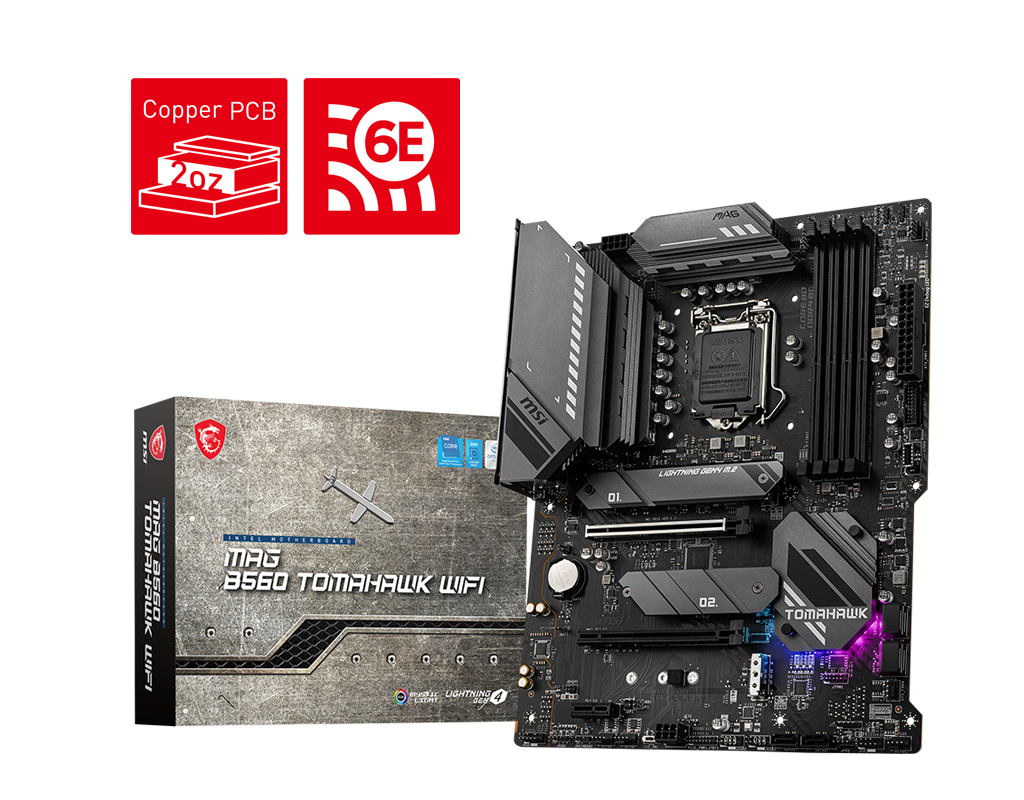One of the best bits of news about Intel’s recent500-series chipset launch was that chipsets other than the Z-series models would support memory overclocking. This means that B560-based boards such as this MSI MAG B560 Tomahawk WiFi can run your memory at frequencies above your gaming CPU’s natively supported speed, which is usually below 3000MHz.
MSI MAG B560 Tomahawk WiFi Review
For example, using a Core i5-10600K on a B460 motherboard would see your memory speed limited to 2666MHz, and no manual tweaks or XMP profiles will allow you to go higher. That’s all changed this time, though, as the likes of the B560 chipset, while still not able to tweak your CPU’s multiplier, can at least hit much higher memory speeds.
The MSI MAG B560 Tomahawk WiFi can reach up to 5066MHz with standard dual-channel memory, and while you likely won’t see much of a real-world performance boost above 3400MHz, that’s way better than 2666MHz.
Another reason to be excited is that this board’s Z590 counterpart costs $60 more, but has a similar specification, albeit with slightly beefier M.2 heatsinks and higher-specification audio. This is important, because many of Intel’s 11th-gen CPUs, such as the Core i9-11900K, have limited overclocking headroom, so the benefits of spending another $60 are limited in terms of extra performance. This board also supports Intel’s Adaptive Boost Technology, which can boost the Core i9-11900K’s clock speeds higher if cooling and power delivery allow it.
The board itself has all the features you would expect from a mid-range enthusiast motherboard, including 802.11ax Wi-Fi, six SATA 6Cbps ports and a handy three M.2 ports, although only the top slot offers PCI-E 4 support for the latest SSDs. The other two ports are limited to PCI-E 3 bandwidth, with one of them also supporting SATA should you have an older drive you want to use. You also get heatsinks for two of those M.2 ports, and our PCI-E 4 SSD was kept below 65°C during our stress test, keeping well away from thermal throttling.
The PCB also offers a USB 3.1 Type-C header, an impressive count of seven 4-pin fan headers, plus both 3-pin and 4-pin RGB lighting headers. It even has a funky cut-out of the PCB next to the PCH heatsink, with the latter being illuminated by RGB lighting.
Power delivery brings 12 phases to the CPU, while two huge heatsinks deal with the heat produced by the VRMs, although they’re not linked by a heatpipe. Even so, they did a good job of keeping the VRMs cool, with our loaded Core i9-11900K only seeing them hit 59°C, which is miles away from throttling levels.
Meanwhile, the rear I/O panel offers a total of eight USB ports, four of which are USB 3, in addition to a USB 3.1 Type-C port. There are also antennae connectors for the 802.11ax Wi-Fi, plus the usual audio jacks, including an optical output, although the audio codec itself is only ALC892, which doesn’t sound as good as the Realtek ALC1220 codec found on more expensive boards.
There are precious few other features, though, with no overclocking and testing tools, such as power and reset buttons, clear-CMOS switches or an LED POST code displays. Instead, MSI has clearly ploughed most of the budget into making sure the board can handle Intel’s most powerful 10th and 11th-gen CPUs.
Performance
The MSI MAG B560 Tomahawk WiFi showed no evidence of being slower than the Z570 boards we’ve tested at stock speed with our Core i9-11900K, matching them in most tests. The stock speed system score is just a little behind the likes of the Asus TUF Gaming Z590-Plus WiFi at 252,341 compared to 263,119, with the Asus board increasing that score to 273,780 once overclocked.
Gaming performance was on par too, and we were also able to enable Intel’s Adaptive Boost Technology on our Core i9-9900K, which saw higher boost frequencies, increasing the Cinebench R23 score from 15,527 to 15,980.
At default settings, the total system power draw of 319W was fairly high under load, though, with the Asus TUF Gaming Z590-Plus WiFi drawing under 300W. The M.2 speeds were identical to other boards too, with a read speed of 4,985MB/sec and write speed of 4,267MB/sec. Meanwhile, the audio performance was fairly typical of the ALC897 codec with a dynamic range of 96.1dBA and noise level of-95.9dBA.
Conclusion
We’re quite impressed with the MSI MAG B560 Tomahawk WiFi. Not only can it provide a good home to cheaper multiplier-locked CPUs such as the Core i5-11400F (see pl6), but it can also handle more powerful K-series CPUs, it can access Adaptive Boost Technology and it can hit the same memory frequencies as Z-series boards.
This means it’s definitely worth asking if you need a Z-series board, and whether you can save cash by going for B560 instead. Given what we’ve seen here, we’d argue that the B560 chipset’s appeal is definitely a lot stronger than previous non-Z-series chipsets.
Given its price, there’s a lack of overclocking-focused features on this board, but it does have decent VRMs and cooling, three M.2 ports and two heatsinks, so you won’t be left wanting for much. If you’re happy to stick to stock CPU speed, but want to use fast memory and save some cash, the MSI MAG B560 Tomahawk WiFi will provide a good home to any Rocket Lake CPU.
Successfully showcases Intel’s B560 chipset It might not overclock your CPU, but it gives you PCI-E 4 support and overclockable memory with change from $180.

